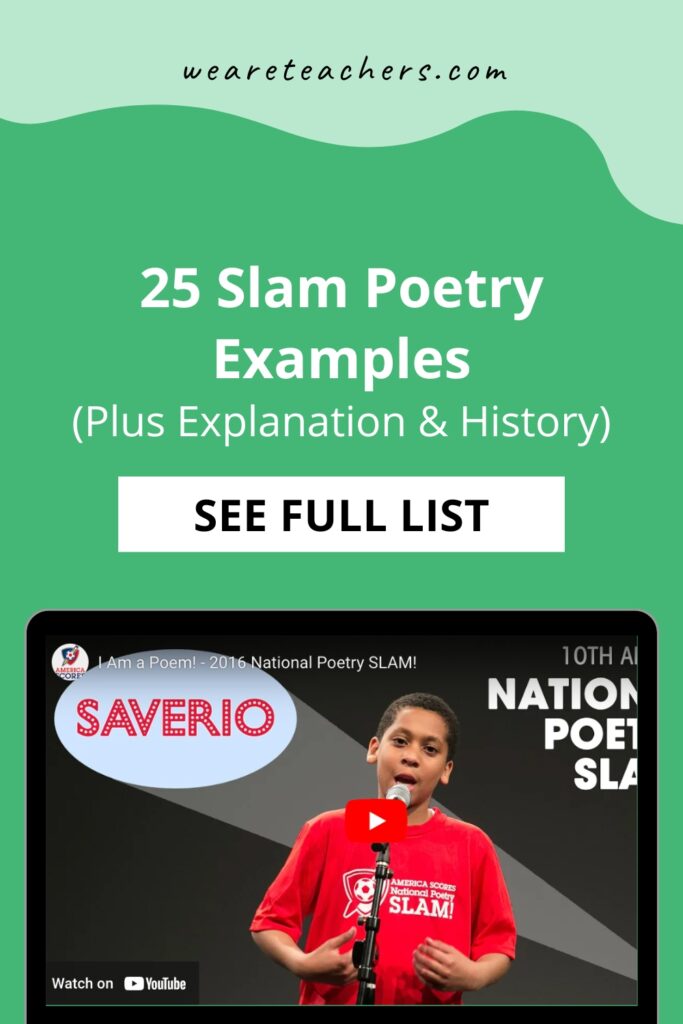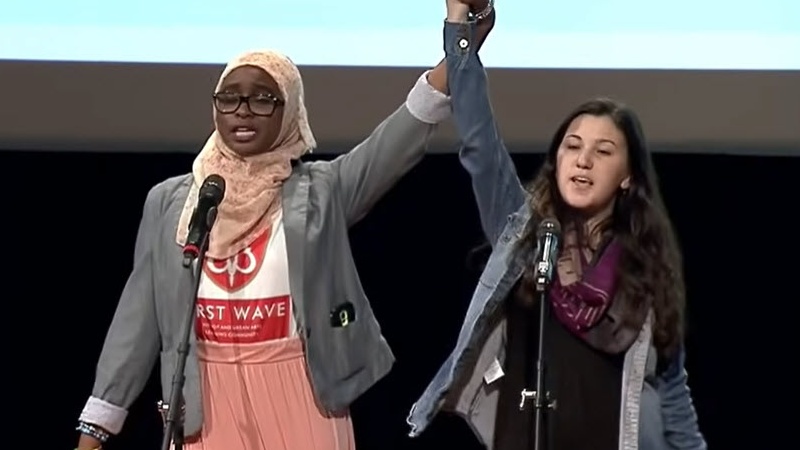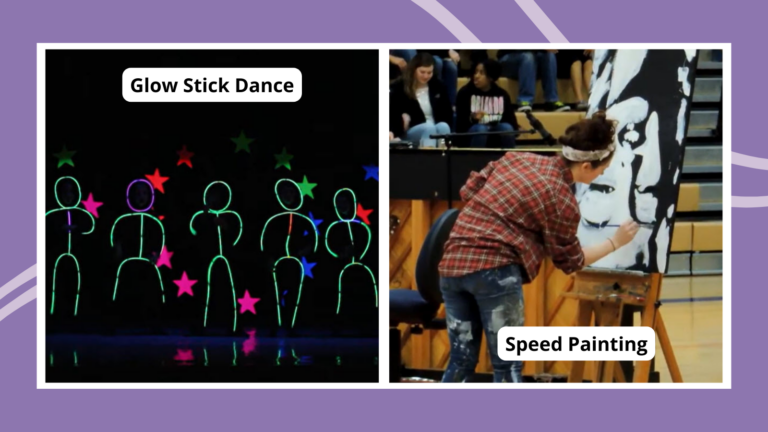Poetry has come a long way since Horatian odes and Shakespearean sonnets. While these types of poems can be a hard sell in the classroom, other forms might inspire a little more excitement. Our suggestion? Include slam poetry examples in your lesson plans! This unique performance art can really help you meet kids where they are and teach them that poetry is as relevant today as it was hundreds of years ago.
What is slam poetry?
This spoken-word performance art seeks to bring a new life and excitement to poetry. Poets perform their poems in front of audiences at competitive events called poetry slams. They do more than just read their poem—they turn it into a high-energy performance with movement, storytelling, and other theatrical elements. Authors may perform on their own or with a larger group.
Often, the poems used at these events are specifically written to be performed. The topics are diverse, frequently political, and thought-provoking. Slam poets want their audiences to feel an emotional response, whether positive or negative. Cheers and calls fill the room as the audience expresses their opinions, making the experience interactive for everyone.
Is slam poetry a poetry genre?
It’s worth noting that not everyone considers “slam poetry” to be a genre of its own. Founder Marc Kelly Smith once said, “There is no such thing as slam poetry. There is only the poetry slam.” In other words, any poem can be performed at a poetry slam without necessarily being specifically written as slam poetry.
That being said, this form of poetry has taken off in such a dynamic way that many sources now consider “slam poetry” to be its own genre. When using this term with students, you may want to share that any poem performed at a slam could be called “slam poetry,” but not everyone considers that term valid.
How did slam poetry start?
In the 1960s, beat poets like Jack Kerouac and Allen Ginsberg introduced a new performance style that caught on with the younger crowd. In the 1980s, a man named Marc Kelly Smith took that concept and brought it a new audience. He was a Chicago poet who wanted shake up the stuffy, academic image of poetry, making it more accessible to everyone. The first National Poetry Slam took place in 1990, and the medium has remained popular ever since.
Why should I use slam poetry with my students?
If your kids roll their eyes when you embark on a poetry unit, try including slam poetry videos or performances in your curriculum. This genre really turns student expectations upside down! Here are a few reasons you should be teaching it:
- Slam poetry is diverse and inclusive. Poetry slams draw people of all types, and students are more likely to see themselves represented.
- The experience is interactive, for both poets and the audience. Kids often think of poetry as quiet and boring, and poetry slams are anything but!
- It gives students a way to explore emotional and intense topics. Many poems performed at slams address political or social themes, encouraging students to tap into their emotions and consider others’ points of view.
- Slam poetry engages multiple learning styles. Reading, writing, performance, storytelling, discussion, and more … it’s all here.
- It’s fun! Seriously, this is like nothing kids have seen before.
The best way to understand a poetry slam is to see it in action. Check out the inspiring examples below to learn more. Note: Poems performed at slams often address heavy political or social topics. Always view videos in advance to make sure they’re appropriate for your audience.
Slam Poetry Examples by Kids and Teens
When your students tell you that only adults can write poems, prove them them wrong with these terrific examples of slam poetry by kids just like them. Some are on lighter subjects, terrific for introducing the concept to little ones. Others tackle the social injustices and political subjects that slam poetry is known for.
I Am a Poem!
Saverio doesn’t just love poems—he is a poem. His clever use of language and poetry terms reminds students that they can find themselves in any literature genre or style. They just have to look.
Soccer Is an Awesome Sport
Slam poetry truly comes to life when you hear it out loud. Riya’s simple poem about soccer abounds with energy through her delivery and excitement.
Cat Poem
Here’s another example of how delivery sets slam poems apart from the rest. These young poets share their thoughts on cats in a way that will make you laugh … and make you think. They subvert expectations, which is what good art is all about.
Where I’m From
This brief but inspiring poem from 11-year-old Ruben captures one child’s life in a few short verses. This is a great way to encourage your students to write their own slam poem using the phrase “Where I’m From.”
Mathematical Blues
Here’s a topic so many kids can relate to: the challenges of math class. The rhyme and rhythm here are great, and the words sum up what lots of this young poet’s peers are thinking every day.
Notes to Beauty
Mel and Alana know that beauty comes in so many different forms, and their poem celebrates them all. Their pop culture references help kids connect with the topic, while their straightforward delivery draws the audience in from the start.
Growing Up
When you’re a teen, you think a lot about growing up. Sometimes you feel so much older and long for childhood. Other times, you feel so young, too young, and wish for more. Anthony’s slam poetry performance captures all these feelings in a way anyone can relate to.
Why Am I Not Good Enough?
Seventh grader Olivia wrote and performed this poem for a class project. Her central theme, “Why am I not good enough?” asks a universal question that so many teens grapple with every day.
Disorder
Sixteen-year-old Chris Loos uses his slam performance to express what it feels like to live with ADHD, OCD, and other “mental disorders.” This powerful piece will speak directly to other students like him. Plus, it will open the minds of those who can’t imagine what it feels like to live this way every day.
Kids These Days
These kids are tired of being labeled, stereotyped, and overgeneralized, especially when it comes to their use of technology. Their performance celebrates the advantages they feel technology is giving their generation, and encourages adults to do the same.
Chingona
“They tell me I’m not Mexican,” Leticia says. But her poem spells out all the ways she embraces and values her background and culture. Regardless of your students’ ethnicities, they’ll see themselves in this search for identity.
A Jewish Girl and a Muslim Girl
Amina and Hannah come from different religions and cultures, but their poem performance celebrates the common ground they share. It’s full of both despair and hope, making connections that unite them.
Somewhere in America
Anger, despair, and fear pour out through the words in this powerful performance. Belissa, Rhiannon, and Zariya ask important questions about American values with an intensity that draws in every viewer. This one is written and performed by kids, but it addresses adult-level topics.
All Lives Matter, but …
Like much slam poetry, Royce’s piece attacks a social and political subject: Black Lives Matter. Viewers feel his anger and fear through his words and his delivery.
Bruise
Levi gave himself a black eye trying to do a somersault. For days, people told him he should make up a better story, like being in a bar fight. He uses his slam poetry performance to fight back against toxic masculinity. (Some PG-13 language.)
Slam Poetry Examples by Adults
These slam poems include award winners and those by famous poets. The topics are often challenging and the language intense, so some of these might be best saved for teens in high school lit classes.
Alexander Hamilton
OK, first things first: This isn’t exactly slam poetry. Slam poetry generally doesn’t include music made with instruments. But Lin-Manuel Miranda’s original performance of the opening number of the smash musical Hamilton was obviously inspired by the genre. Note that there’s very little singing—it’s all about the rhyme, rhythm, and flow of the words. You could remove the music, and the impact would be very much the same.
My Father’s Coat
Marc Kelly Smith is often considered the founder of the slam poetry movement. Watch him perform one of his most well-known poems, a thought-provoking piece about whether a father’s coat really fits his son.
59
Harry Baker’s slam poetry uses puns and humor to tell poignant stories. In this one, prime number 59 stops yearning after perfect 60 and falls in love with 61, a prime example of a love story.
What Kind of Asian Are You?
Alex Yang knows what it feels like to be lumped together, to have his individuality stripped away. He shares those feelings and experiences in this intense slam poetry performance.
Unreliable
Sarah Kay is a well-known poet, sometimes performing with her partner, Phil Kaye (no relation). In this work, she calls herself the most unreliable of narrators, noting that she constantly lies to herself. “I am the center of my own dramatic universe,” she notes. What teen can’t relate to that?
To This Day
Shane’s captivating poem about bullying took the world by storm. He edited his original TED Talk performance video to use in school talks. (If you’d like to see the whole thing, find it here.)
Totally Like Whatever, You Know
Taylor Mali wonders when we stopped speaking with conviction and turned everything into a question. Your students will definitely recognize themselves in the speech patterns of this poem, and it might just change the way they think—and talk. (Mali is a former classroom teacher, by the way, and educators will connect with his poem What Teachers Make.)
My Honest Poem
What starts out as a list of facts turns into a deeper look at identity. Rudy Francisco’s poems are powerful but relatable, and many of them are great for the classroom.
Unfinished
Before he starts his poem, Nkosi Nkululeko has a few thoughts to share. And then a few more. And a few more after that …
Ode to Sister
If your students still aren’t sure about slam poetry, remind them about Brandon Leake, who ultimately won the 2020 season of America’s Got Talent with his incredible compositions. Here’s his initial audition, which even Simon Cowell couldn’t criticize.
Do poetry slams have rules?
Though different events may set their own rules, here are some of the common guidelines of poetry slams.
- Any style of poetry is acceptable, but the author generally must be involved in performing their own poem.
- There’s no need to memorize your poem, though many do. Poets are welcome to use notes on paper or in digital form.
- Poem performances are usually limited to three minutes or less.
- No props or costumes are allowed, although you may dress in a way that matches the theme or mood of your poem.
- Performances cannot include pre-recorded music or sound effects or musical instruments. However, the performer is welcome to add their own sounds by beatboxing, singing, clapping, or using their body in other ways.
How are competitions judged?
Poetry slams are often judged competitions, each with its own rules. Usually a panel of judges is chosen in advance. They may be people with expertise in poetry, or they could just be people from the audience. The judges award scores, often on a scale of 1 to 10. (In some competitions, they drop the highest and lowest scores.) These individual scores are added together to give a final score. The highest score wins the competition.
How do I hold a poetry slam?
Thinking of holding your own slam? Go for it! Just remember that not all students are comfortable performing in front of their peers. Plus, be sure to offer some guidance to the audience on constructive ways to offer their feedback. These resources can help:
- How To Host Your Own Schoolwide Poetry Slam
- Poetry4Kids: How To Host a Poetry Slam
- Become a Writer Today: How To Poetry Slam—A Detailed Guide
Looking for more ways to inspire students with poetry? Check out 15 Types of Poetry To Share With Kids (Plus Examples of Each).
Plus, get all the latest teaching tips and ideas, straight to your inbox, when you sign up for our free newsletters!


